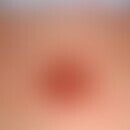Synonym(s)
HistoryThis section has been translated automatically.
DefinitionThis section has been translated automatically.
X-linked dominant hereditary neuroectodermal disease of childhood, present at birth or occurring within the first week of life (almost 100%), affecting the skin, nails, hair, teeth and eyes. Initially, an inflammatory skin disease is impressive, which in the later "non-inflammatory stage IV" leaves spatter-like pigmentation and atrophy.
You might also be interested in
Occurrence/EpidemiologyThis section has been translated automatically.
Incidence: 1/50.000 births/year.
EtiopathogenesisThis section has been translated automatically.
X-linked dominant inheritance of mutations of the NF-kappa-B essential modulator gene(IKBKG gene formerly known as NEMO gene; gene locus: Xq28). In 64% of cases, this is a new mutation. This gene encodes a protein that is responsible for the regulation of various cytokines, chemokines and adhesion molecules. It is essential for protection against TNF-alpha-induced apoptosis.
The mutations are only compatible with life if they are present as a genetic mosaic. Mosaics develop most frequently in women in the context of X-linked inactivation. Affected male fetuses usually die in utero. Genetic mosaics rarely occur in male patients due to Klinefelter syndrome, chromatid mutations or early somatic mutations.
ManifestationThis section has been translated automatically.
LocalizationThis section has been translated automatically.
Mainly extremities, lateral trunk areas.
ClinicThis section has been translated automatically.
- The disease progresses in phases and presents itself on the integument in different clinical forms, which can be divided into 4 (partly overlapping) stages:
- Stage 1 (birth to 4th month): Red vesicles, blisters, (eosinophilic) pustules, papules, plaques in a striped or girdle-shaped, sometimes also whorled arrangement ( Blaschko's lines).
- Stage 2 (2nd-6th month): Healing of the acute manifestations. Formation of hyperkeratotic, yellow-brownish, verrucous plaques
- Stage 3 (7th month - 12th year of life): dirty brown or steel to slate gray, spatter-like, striped or garland-like, also annular patches.
- Stage 4 (6th year of life to adulthood): Lesions are pale. Development of hypopigmented, atrophic scars with hair abnormalities (in 50% of cases), alopecia and loss of sweat glands.
- Note: In rare cases, a reactivation of vesicular stage 1 may occur, e.g. in the context of an infection (Juan CK et al. 2015). Stages 1-3 may already be complete at birth (Sigl J et al. 2020)
- Malformations of other organs:
- Tooth and jaw (67-90% of patients): Tooth hypoplasia, hypodontia, peg teeth, microdontia, prognathism
- Eyes (20-70% of patients): Strabismus (about 20%), pseudoglioma retinae, corneal and lens opacities, pigmentary dystrophy and retinal detachment, optic atrophy, microphthalmia, blue sclera, ptosis
- CNS (20- 30% of patients) microcephaly, debility, spastic diplegia, seizures (most common neurological symptom) intellectual deficits (approx. 10% of patients), ataxia
- Skeleton (sporadic): hip joint dysplasia, syndactyly
- Heart (sporadic): Endomyocardial fibrosis, tetralogy of Fallot
- Nails (sporadic): dimples, onychogryposis
- Concomitant:
- Blood- (stage 1: 35% of patients. Blood eosinophilia can be excessive up to 80% of peripheral leukocytes). Blood eosinophilia reduced in later stages (in stage 4 only in 10% of patients)
- Tissue eosinophilia
LaboratoryThis section has been translated automatically.
High blood and tissue eosinophilia (blood eosinophilia in about 35% of patients).
HistologyThis section has been translated automatically.
Intraepidermal and subcorneal blisters with abundant eosinophilic cells, acanthotic widened, spongiotically loosened epidermis with single cell keratinization. In stages 3 and 4: considerable accumulations of melanin (pigment incontinence) in the dermis. There in melanophages.
Differential diagnosisThis section has been translated automatically.
Epidermolysis bullosa group: no arrangement in the Blaschko lines
ILVEN: usually manifested at a later age.
Incontinentia pigmenti, Franceschetti-Jadassohn type
Melanodermitis toxica: no arrangement in the Blaschko lines
Urticaria pigmentosa: no arrangement in the Blaschko lines, Darier's sign can be triggered
Lichen planus: no phased development since birth. Histology is diagnostic.
Schimmelpenning-Feuerstein-Mims syndrome: The skin lesions are already present at birth and arranged in a linear pattern. No inflammatory signs. Histology is diagnostic: nevi sebacei; head and neck preferred.
External therapyThis section has been translated automatically.
In the inflammatory stage short-term potent glucocorticoids such as prednicarbate (e.g. Dermatop cream). In case of blister formation, moist compresses with antiseptic additives such as potassium permanganate (light pink).
Internal therapyThis section has been translated automatically.
Progression/forecastThis section has been translated automatically.
Skin symptoms regress until adulthood, possibly slight hypopigmentation and partial scars. Otherwise depending on the accompanying diseases (especially seizure disorders).
Only in exceptional cases does a recurrence of the inflammatory phases occur in later stages (e.g. infection-associated)
ProphylaxisThis section has been translated automatically.
It is recommended to arrange for a genetic examination of the mother!
LiteratureThis section has been translated automatically.
- Bardaro T et al. (2003) Two cases of misinterpretation of molecular results in incontinentia pigmenti, and a PCR-based method to discriminate NEMO/IKKgamma dene deletion. Hum Mutat 21: 8-11
- Berlin AL et al. (2002) Incontinentia pigmenti: a review and update on the molecular basis of pathophysiology. J Am Acad Dermatol 47: 169-187
- Bloch B (1926) Peculiar, hitherto undescribed pigmentary affection (Incontinentia pigmenti). Schweiz med Wschr 56: 404-405
- Carney R (1976) Incontinentia pigmenti. A world statistical analysis. Arch Dermatol 112: 535-542
- Conte MI et al. ()2014) Insight into IKBKG/NEMO locus: report of new mutations and complex genomic rearrangements leading to incontinentia pigmenti disease. Hum Mutat 35:165-177
- Garrod AE (1906) Peculiar pigmentation of the skin in an infant. Trans Clin Soc London 39: 216
- Happle R (2003) A fresh look at incontinentia pigmenti. Arch Dermatol 139: 1206-1208
- Juan CK et al. (2015) Flare-up of incontinentia pigmenti in association with Behçet disease. J Dtsch Dermatol Ges 13:154-156.
- Kleszky M et al (1985) Incontinentia pigmenti Bloch-Sulzberger. Dermatol Mschr 171: 181-122
- Landy SJ, Donnai D (1993) Incontinentia pigmenti (Bloch-Sulzberger syndrome). J Med Genet 30: 53-59
- Phan TA et al. (2005) Incontinentia pigmenti case series: clinical spectrum of incontinentia pigmenti in 53 female patients and their relatives. Clinical dermatology 30: 474-480
- Schaller J et al. (1992) Disseminated incontinentia pigmenti Bloch-Sulzberger. Dermatology 43: 383-385
- Sigl J (2025) et al (2020) An unusual course of incontinentia pigmenti. J Dtsch Dermatol Ges 18:133-135
- Sulzberger MB (1927) On a previously undescribed congenital pigmentary anomaly (incontinentia pigmenti). Arch Derm Syph 154: 19-32
- Yang Yet al. (2014)Neonatal incontinentia pigmenti: Six cases and a literature review. Exp Ther Med 8:1797-1806
Incoming links (23)
Ashy dermatosis; Berlin syndrome; Blaschko lines; Bloch-sulzberger syndrome; Dermatitis herpetiformis; Eosinophilic pustular folliculitis; Goltz syndrome; Hypermelanosis nevoid, striped and vertebral; Hypomelanosis ito; IKBKG Gene; ... Show allOutgoing links (20)
Acanthosis; Apoptosis; Blaschko lines; Cytokines; Epidermolysis bullosa hereditaria (overview); Glucocorticosteroids; IKBKG Gene; Ilven; Klinefelter's syndrome; Lichen planus classic type; ... Show allDisclaimer
Please ask your physician for a reliable diagnosis. This website is only meant as a reference.










